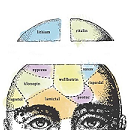Elif Batuman reviews the science and recounts his experiences with transcranial direct-current stimulation in The New Yorker.
“I could see he was ready to answer more questions. But, as warned, I felt almost completely unable to speak,” writes Batuman. “It wasn’t like grasping for words; it was like no longer knowing what words were good for. Clark offered to drive me back to my hotel. Everything was mesmerizing: a dumpster in the rear-view camera, the wide roads, the Route 66 signs, the Land of Enchantment license plates.”
“This was my first experience of transcranial direct-current stimulation, or tDCS — a portable, cheap, low-tech procedure that involves sending a low electric current (up to two milliamps) to the brain,” explains Batuman. “Research into tDCS is in its early stages. A number of studies suggest that it may improve learning, vigilance, intelligence, and working memory, as well as relieve chronic pain and the symptoms of depression, fibromyalgia, Parkinson’s, and schizophrenia. However, the studies have been so small and heterogeneous that meta-analyses have failed to prove any conclusive effects, and long-term risks have not been established. The treatment has yet to receive F.D.A. approval, although a few hospitals, including Beth Israel, in New York, and Beth Israel Deaconess, in Boston, have used it to treat chronic pain and depression.”
Electrified (The New Yorker, April 6, 2015)











